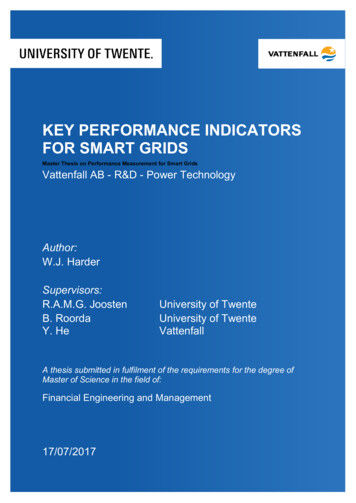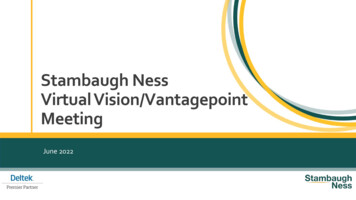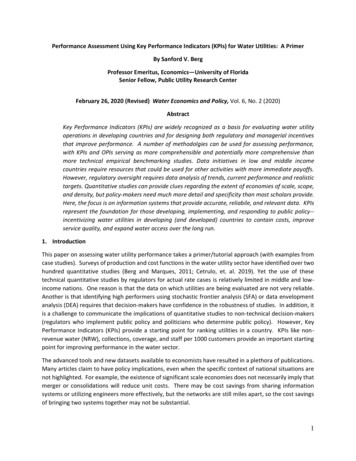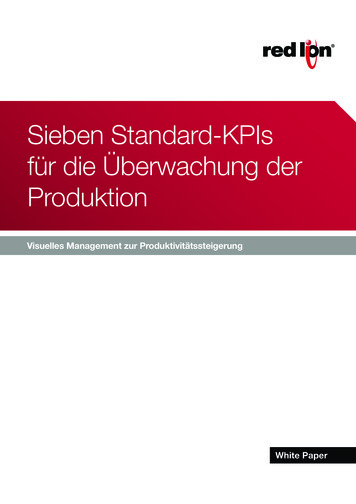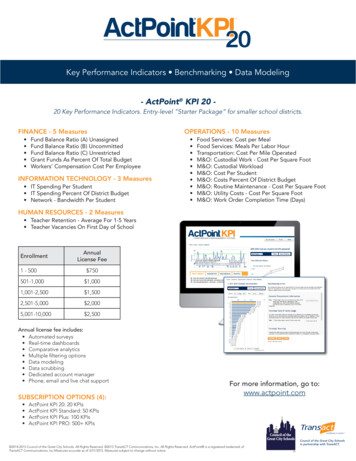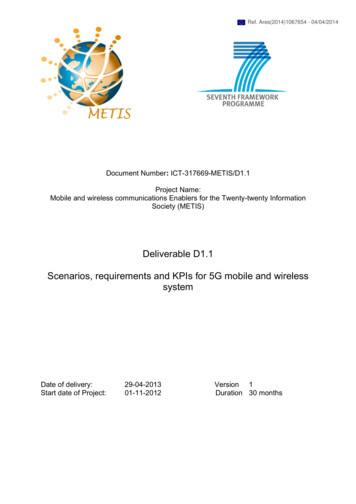
Transcription
Ref. Ares(2014)1067654 - 04/04/2014Document Number: ICT-317669-METIS/D1.1Project Name:Mobile and wireless communications Enablers for the Twenty-twenty InformationSociety (METIS)Deliverable D1.1Scenarios, requirements and KPIs for 5G mobile and wirelesssystemDate of delivery:Start date of Project:29-04-201301-11-2012Version 1Duration 30 months
Deliverable D1.1Scenarios, requirements and KPIs for 5G mobileand wireless systemProject Number:ICT-317669Project Name:Mobile and wireless communications Enablers for theTwenty-twenty Information SocietyDocument Number:ICT-317669-METIS/D1.1Document Title:Scenarios, requirements and KPIs for 5G mobile andwireless systemEditors:Mikael Fallgren, Bogdan Timus (Ericsson AB)Authors:Petar Popovski (Aalborg University), Volker Braun,Hans-Peter Mayer (Alcatel-Lucent Bell Labs), PeterFertl, Zhe Ren, David Gonzales-Serrano (BMW GroupResearch and Technology), Erik Ström, TommySvensson (Chalmers University of Technology),Hidekazu Taoka, Patrick Agyapong, Anass Benjebbour(DOCOMO), Gerd Zimmermann (Deutsche TelekomAG), Juha Meinilä, Juha Ylitalo (Elektrobit), TommiJämsä, Pekka Kyösti (Anite), Konstantinos Dimou,Mikael Fallgren, Yngve Selén, Bogdan Timus, HugoTullberg (Ericsson AB), Malte Schellmann, Yuxiang Wu,Martin Schubert (Huawei ERC), Du Ho Kang, Jan IMarkendahl, Claes Beckman (KTH), Mikko Uusitalo,Osman Yilmaz, Carl Wijting, Zexian Li (Nokia), PatrickMarsch, Krystian Pawlak, Jaakko Vihriala (NokiaSiemens Networks), Alexandre Gouraud, SébastienJeux (France Telecom - Orange), Mauro Boldi, GianMichele Dell'aera, Bruno Melis (Telecom Italia), HansSchotten (University of Kaiserslautern), PanagiotisSpapis, Alex Kaloxylos, Konstantinos Chatzikokolakis(National and Kapodistrian University of Athens)Dissemination Level:PUContractual Date of Delivery:01/05/2013Status:PublicVersion:1File Name:METIS D1.1 v1.docxMETISPublicii
Abstract:This deliverable introduces generic scenarios based on fundamental challenges, and thespecific problem description of test cases that will be relevant for beyond future radio access.Specific characteristics of each scenario and each test case include the key assumptionsregarding requirements and key performance indicators. In order not to constrain the potentialsolutions, the requirements are specified from an end-user perspective. The deliverable willnot only serve as the guideline for the technical work and system concept design in METIS,but also can serve in external research communities to help to harmonize the work towardsthe future radio access system including the new generation system of 5G.Keywords:Scenario, KPI, test case, requirement, challenge, end-user, electromagnetic field exposure,traffic volume density, experienced user throughput, E2E latency, reliability, availability,retainability, energy consumption, cost.METISPubliciii
rity:29/04/2013PublicVersion:Public1Executive summaryThe overall goal of the METIS project is to lay the foundation for the beyond 2020 5Gmobile and wireless system by providing the technical enablers needed to address therequirements foreseen for this time frame.Deliverable D1.1 introduces five scenarios based on five challenges that will berelevant for the considered time frame and which are wide in scope. Those area) “Amazingly fast” focuses on high data-rates for future mobile broadband users,b) “Great service in a crowd” focuses on mobile broadband experience even in thevery crowded areas and conditions,c) “Ubiquitous things communicating” focuses on efficient handling of a very largenumber of devices (including e.g. machine type of devices, and sensors) withwidely varying requirements,d) “Best experience follows you” focuses on end-users on the move with highlevels of experience, ande) “Super real-time and reliable connections” focuses on new applications and usecases with very strict requirements on latency and reliability.To facilitate the work with more specific research questions D1.1 further definestwelve concrete test cases based on the above scenarios. Each such test casetypically contains challenges from one or more scenarios. The aim of the test cases isto provide distinct problem descriptions, requirements, and Key PerformanceIndicators (KPIs) from the end-user perspective. They will be used by the METISproject as a basis for designing and evaluating technical solutions. For brevity, onlythe main challenges and descriptions of each test case are provided in the D1.1 mainsections. Underlying assumptions and more detailed requirement descriptions arepresented in the Annex.Although the test cases described in this document are rather specific, the solutionsderived from them are expected to address a much wider class of problems relevantfor the same fundamental challenges that the test cases are based on. The concretetest case KPIs provide a direction for research and a measure of success for METIS.Finally, D1.1 will be used to identify research items for the other work packages (WPs)and for the horizontal topics (HTs) within METIS. Based on the test cases, METIS willpropose candidate solutions and map the end-user KPIs to solution-specific KPIs.METIS will then develop and evaluate technical components addressing the end-userand solution-specific KPIs. The various technical components and solutions will beintegrated into a unified METIS concept that addresses the fundamental challenges ofthe beyond 2020 information society.METISPublicv
duction .11.1Future radio access .11.2Structure of the document.22 Methodology .32.1Terminology .32.2Approach.53 Scenario overview.63.1Challenges .63.2Scenarios .73.2.1Amazingly fast .73.2.2Great service in a crowd .83.2.3Ubiquitous things communicating .93.2.4Best experience follows you .93.2.5Super real-time and reliable connections .103.3Test cases.103.3.1TC1: Virtual reality office.113.3.2TC2: Dense urban information society .123.3.3TC3: Shopping mall .123.3.4TC4: Stadium.123.3.5TC5: Teleprotection in smart grid network.133.3.6TC6: Traffic jam .133.3.7TC7: Blind spots .143.3.8TC8: Real-time remote computing for mobile terminals .143.3.9TC9: Open air festival .153.3.10 TC10: Emergency communications.153.3.11 TC11: Massive deployment of sensors and actuators.163.3.12 TC12: Traffic efficiency and safety .163.4Common assumptions .174 Key Performance Indicator overview .184.1General considerations .184.2KPI definitions .194.2.1Traffic volume density.194.2.2Experienced user throughput.214.2.3Latency .224.2.4Reliability .234.2.5Availability and retainability.244.2.6Energy consumption .254.2.7Cost .264.3Requirements and KPIs .275 Summary.306 References.317 Annex - TC1: Virtual reality office.367.1Background and motivation .367.2Requirements and KPI.368 Annex - TC2: Dense urban information society .388.1Background and motivation .388.2Requirements and KPIs .389 Annex - TC3: Shopping mall .419.1Background and motivation .419.2Requirements and KPIs .4210 Annex - TC4: Stadium.4410.1Background and motivation.4410.2Requirements and KPIs .44METISPublicvi
rity:29/04/2013PublicVersion:Public111 Annex - TC5: Teleprotection in smart grid network.4611.1Background and motivation.4611.2Requirements and KPIs .4612 Annex - TC6: Traffic jam .4812.1Background and motivation.4812.2Requirements and KPIs .4813 Annex - TC7: Blind spots .5013.1Background and motivation.5013.2Requirements and KPIs .5014 Annex - TC8: Real-time remote computing for mobile terminals .5214.1Background and motivation.5214.2Requirements and KPIs .5215 Annex - TC9: Open air festival .5515.1Background and motivation.5515.2Requirements and KPIs .5516 Annex - TC10: Emergency communications.5816.1Background and motivation.5816.2Requirements and KPIs .5817 Annex - TC11: Massive deployment of sensors and actuators.6017.1Background and motivation.6017.2Requirements and KPIs .6117.2.1 Requirements .6117.2.2 Key Performance Indicators (KPIs) .6218 Annex - TC12: Traffic safety and efficiency .6618.1Background and motivation.6618.2Requirements and KPIs .6819 Annex - Mapping the test cases and the scenarios .7220 Annex - Energy consumption and cost aspects .7320.1Network infrastructure power consumption model .7320.2UE power consumption model .7320.3Operator cost model.74METISPublicvii
rity:29/04/2013PublicVersion:Public1List of Abbreviations, Acronyms, and IMTITSMETIS2nd Generation3 Dimensions3rd Generation3rd Generation Partnership Project4th Generation5th GenerationAcknowledgementBit Error RateCAPital EXpenditureCumulative Distribution FunctionContent Delivery NetworkCooperative-Intelligent TrafficSystemsComité Européen deNormalisation ÉlectrotechniqueCustomer Premise EquipmentCentralized Radio Access NetworkCircuit ntinuous ReceptionDiscontinuous TransmissionEvolved Universal TerrestrialRadio Access NetworkEnd-to-EndEnergy Efficiency EvaluationFrameworkEnergy Aware Radio and networktecHnologiesElectronic Control UnitsElectro Magnetic FieldEvolved NodeBEuropean TelecommunicationsStandards InstituteEuropean UnionFrequency Division DuplexFramework programmeGigabit per secondGigabyteGeneric Object OrientedSubstation EventsGlobal System for MobilecommunicationsHybrid Automatic Repeat reQuestHorizontal TopicInformation and CommunicationsTechnologyInternational ElectrotechnicalCommissionInstitute of Electrical andElectronics EngineersImage MaximumInternational MobileCommunicationsIntelligent traffic 2DV2VV2XVoIPVRUPublicInternet ProtocolInternational TelecommunicationUnion-RadioKey Performance IndicatorLow EnergyLong Term EvolutionMachine-to-MachineMedium-Access ControlMobile BroadBandMegabit per secondMegabyteMassive Machine CommunicationMobile Network OperatorNot ApplicableNext Generation Mobile NetworkOPerational EXpenditureOne Trip TimePersonal ComputerPacket Data ConvergenceProtocolProbability Density FunctionPacket Delivery RatePacket Error RatePhysicalProtective RelayQuality of ExperienceQuality of ServiceRadio Access NetworkRadio FrequencyRadio Link ControlRound Trip TimeReceiverSAfe Road TRains for theEnvironmentSymbol Error RateSignal to Interference plus NoiseRatioShort Message ServiceTerabit per secondTerabyteTest CaseTransmission Control ProtocolTime Division DuplexTransmission Time IntervalTelevisionTransmitterUser EquipmentUpLinkUniversal MobileTelecommunications SystemUnited States o-anythingVoice over Internet ProtocolVulnerable Road Usersviii
Document:Date:Status:WiFiMETISWireless 13PublicVersion:WPPublicPublic1Work Packageix
rity:29/04/2013PublicVersion:Public11 IntroductionSocietal development will lead to changes in the way mobile and wirelesscommunication systems are used. In METIS’ vision about the future informationsociety private and professional users will be provided with a wide variety ofapplications and services, ranging from infotainment services, through increasedsafety and efficient usage of transportation, to completely new industrial andprofessional applications. This vision results in challenges such as the very high datarates, and the very dense crowds of users, with higher requirements on the end-to-endperformance and user-experience. New types of challenges that arise from newapplication areas are the very low latency, and the very low energy, cost, and massivenumber of devices. In many cases one key challenge regards support of efficientmobility. To address these challenges, METIS will provide the technical enablers thatwill essentially lay the foundation of the future 5G communications systems.This document identifies the fundamental future challenges and defines a systemconcept. Each challenge is reflected by a scenario description. Real-world applicationsmight often entail more than one of the fundamental challenges. In order to ensurethat the developed technical enablers meet the requirements of the identifiedchallenges and future 5G communication systems twelve concrete test cases aredefined to reflect these fundamental challenges. The selected test cases essentiallysample the space of future applications, both human-centric and machine-type. Oncethe tested technical enablers fulfil the requirements for these test cases it is expectedthat many other applications, with the same fundamental challenges, will successfullybe supported.1.1 Future radio accessThe main objective of METIS is to respond to societal challenges beyond 2020 byproviding the basis for the all-communicating world and lay the foundation for a futureradio access mobile and wireless communications system. This will realize the METISvision of a future where access to information and sharing of data is availableanywhere and anytime to anyone and anything. METIS will develop a concept for thefuture 5G mobile wireless communications system and will identify the research keybuilding blocks of such a future system. The METIS overall technical goal provides asystem concept that, relative to today, supports: 1000 times higher mobile data volume per area, 10 times to 100 times higher number of connected devices, 10 times to 100 times higher typical user data rate, 10 times longer battery life for low power Massive Machine Communication(MMC) devices, 5 times reduced End-to-End (E2E) latency.The key challenge is to achieve these objectives at a similar cost and energyconsumption as today’s networks [1].The main goal of this deliverable is to describe specific scenarios that capture theMETIS objectives as described above. The identified scenarios and test cases aim atcapturing the needs from an end-user perspective. Specific characteristics of eachMETISPublic1
rity:29/04/2013PublicVersion:Public1scenario and each test case will be derived including elaboration of the keyassumptions regarding requirements and Key Performance Indicators (KPIs).This document aims to guide and support the technical work within the project. Theidentified scenarios and test cases define a problem space, with focus on itsrequirements. They are mostly end-user centric, but aspects relevant for otherimportant actors e.g. society and mobile network operators, such as energyconsumption or costs are also included. However, they do not describe the possiblesolutions for any of the described problems, nor do they describe solution-specificrequirements and KPIs. For the reference, in METIS, the description on solutionspecific requirements and KPIs will be delivered from the technical WPs, e.g.requirements relevant for new air interface will be delivered as D2.1 and the futurespectrum needs and usage principles will be published as D5.1.1.2 Structure of the documentThe rest of the document is organised as follows: Section 2 captures the methodology used to describe the identified scenariosand provides definitions of the terms included in the document. Section 3 provides a description of the scenarios, namely “Amazingly fast”,“Great service in a crowd”, “Ubiquitous things communicating”, “Bestexperience follows you”, and “Super real-time and reliable connections”. Thenthe separate test cases, comprising the aforementioned scenarios, are brieflydescribed. Section 4 describes the identified KPIs that will be used to evaluate theperformance of the METIS solutions. Section 5 contains conclusions of the findings.In addition, this document has an Annex. Here, a more detailed description of eachtest case is provided, Section 7 to Section 18, including background and motivation aswell as requirement and KPI details. Furthermore, the scenario and test case mappingtable is given in Section 19 and additional information regarding the energyconsumption and cost KPIs are presented in Section 20.METISPublic2
rity:29/04/2013PublicVersion:Public12 MethodologyAccording to METIS vision, the use of future wireless communication systems willexpand into new areas of applications. Due to the uncertainty about the future, onecan consider many possible futures. METIS will provide technical components thatcan address the challenges of the unknown future. The underlying idea of the appliedmethodology is that the technical components will be able to address the unknownfuture, if they can handle a relatively small number of suitably selected test cases.The test case selection is done as follows. Firstly, the possible futures are treated as aproblem space. Each problem is seen from an end-user perspective and obviouslyhas some underlying technical challenges. Secondly, the space is spanned by ahandful of fundamental challenges. Each challenge is illustrated by a scenario, whichis described in general terms, from an end-user perspective. By describing thechallenge-scenario pairs as the two faces of a coin, Section 3 in this document makesthe connections between the technical issues that METIS will address and what theend-user in the information society will be provided with. Thirdly, the problem space issampled by a dozen concrete test cases. The requirements of a test case are primarilydefined from an end-user perspective, but also other aspects are taken intoconsideration whenever relevant, such as energy consumption or cost. Each test casemay have several challenges and therefore typically belongs to several scenarios. Asuitable selection of test cases means that the tested technical component, and theMETIS concept that builds upon them, will be able to handle the space of possiblefuture problems.2.1 TerminologyIn this subsection, definitions are provided for the methodology concepts and terms;moreover, the interrelations between such concepts are provided. The termscomposing the METIS methodology, together with their definitions, are listed below: Challenge: The fundamental technical difficulty of posed by possible futures. Itis illustrated by scenario, for which it highlights the most demanding aspect ofthe underlying technical problem. Scenario: “An internally consistent view of what the future might turn out to be”,Michael Porter [2]. In the following, this view is given as a general account of asituation or course of actions that may occur in the future [3]. It is describedfrom end-user perspective and it illustrates a fundamental challenge. Test case: A practical aspect formulated from end-users’ perspective. Eachtest case also contains a set of assumptions, constraints, and requirements. Ascenario may cover several concrete test cases; a test case may have severalchallenges and therefore belong to several scenarios. Requirement: Captures the technical needs derived from the user needs so asto drive research towards this direction. It may be related to e.g. traffic needs,energy, and spectrum. Key Performance Indicator (KPI): A quantifiable measurement, agreed tobeforehand, that reflect the critical success factors of a proposed solution; itreflects the goals captured by each test case. The KPIs are linked to the testcase so as to link the proposed solutions with the usage driven test cases.METISPublic3
rity:29/04/2013PublicVersion:Public1 Legacy solution: A solution that used to deal with the proposed user orientedtest case before a METIS solution is implemented. A new METIS solution mightcomplement the legacy solution or to be competitive to it. Assumption: The preconditions and conjunctures. The assumptions arerelated to e.g. data traffics, roles of actors, and traffic models. Model: A probabilistic description of the test case environment and context.The models are containing e.g. description of the environment, users anddevices distribution, data traffic, spectrum to be used, and energy consumption.The terms composing the METIS methodology are depicted in Figure 2.1 together withthe identified relations between the terms.RequirementRequiremenLegacy asBelongs toReflectsOutlines theobjectives ofTest CaseRequirementRequirementRequirementDoes notmeetAssessesRequirementRequiremKPI entScenarioAssumptionAssumptionsAssumptionOutlines thescope ofDescribedbyModelFigure 2.1: Relation between methodology terms.The relation between the methodology terms in Figure 2.1 can be traced as follows: Challenge. The set of Challenges outline the objectives of METIS. Scenario. The Scenarios outline the scope of METIS. Each scenario reflectsone specific Challenge. Test Case. A test case reflects one or more Challenges and belongs to one ormore Scenarios. Each test case has a set of:o Legacy Solutions. A legacy solution does not meet all requirements posed by thetest case, but may complement the METIS solutions.o Requirements. A requirement is defined from the end-user perspective.o KPIs. A KPI assesses a (set of) requirement(s).o Assumptions. METISAn assumption is being described by a Model.Public4
rity:29/04/2013PublicVersion:Public12.2 ApproachMETIS covers a wide range of technologies which address different protocol layers,different end-user and technical challenges. This diversity represents a real difficultywhen defining scenarios and requirements. The following guidelines have been used: Avoid tailoring scenarios and requirements for specific technology components.The scenarios and requirements are primarily defined from the end-userperspective and are solution-agnostic. This allows for solutions and networkarchitectures to be compared, that includes, but not limit to, traditional cellularnetworks. The requirements capture also other aspects, such as the energyconsumption and cost which are relevant for a mobile operator’s perspective. Provide concrete and general scenarios.Initially a set of fundamental future challenges, where each challenge belongs to ascenario, were identified. The scenario focuses on its specific challenge, althoughother challenges may also be relevant in parts of the described scenario.The realistic test cases focus on user related problems that may contain several of thechallenges. The test case belongs to a group of scenarios that is identified by thechallen
METIS will then develop and evaluate technical components addressing the end-user and solution-specific KPIs. The various technical components and solutions will be integrated into a unified METIS concept that addresses the fundamental challenges of the beyond 2020 information society.
